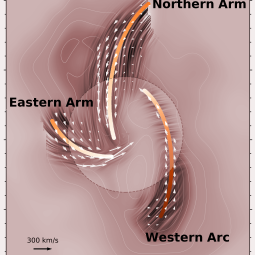by Jordan Guerra and Joan Schmelz
Paper:
The Strength of the Sheared Magnetic Field in the Circum-Nuclear Disk
Guerra, J.A., Lopez-Rodriguez, E., Chuss, D. Butterfield, N., Schmelz, J.T. (2023), Astrophysical Journal, submitted
In the inner five parsec of the Galactic Center, there exists a region of dense molecular gas (~10 4 cm -3 ) and hot dust known as the Circumnuclear Disk (CND). The influence of the central black hole associated with the Sgr A* radio source is so important in this region that astronomers have always assumed that gravity would dominate the dynamics. New findings, however, suggest that magnetic fields in the CND may be strong enough to significantly influence the accretion of material onto Sgr A*.
The gas-dominated version of the CND is motivated, in part, by the detection of three streamers -- the Northern Arm, the Eastern Arm, and the Western Arc (see figure) -- in the inner region of the CND. These streamers consist of ionized material falling toward Sgr A* in approximate Keplerian orbits with velocities of up to 500 km/s. On the other hand, polarimetry data obtained with the High-resolution Airborne Wideband Camera Plus (HAWC+) onboard SOFIA indicates that the magnetic fields that thread the hot dust co-located in the CND are largely aligned with the direction of the streamers.
The magnetic fields may function as rigid channels and the material just flows along, or the material may be falling gravitationally and the magnetic field is just “along for the ride.” Determining which of these scenarios applies in the CND requires understanding the balance of energies involved, and the magnetic field strength is a necessary prerequisite.
One way to infer the magnetic field strength from these observations is through the Davis-Chandrasekhar-Fermi (DCF) method, which explains the deviation in the magnetic field due to the gas turbulence as an Alfvén wave. However, this “classical” approximation does not take into account the effects of any type of flow, including the shear flow occurring in the CND streamers. To overcome this limitation of the DCF method, the new results describe analytically the propagation of an Alfven wave along a shear flow aligned with the magnetic field, leading to a shear-flow modified version of the DCF approximation.
Applying the new shear-flow modified DCF approximation to synthetic polarized dust observations made from magnetohydrodynamics simulations, inferred plane-of-sky magnetic field strengths deviated only 3% - 22% from fiducial values, compared to ~50% from the classical DCF. Applying the new shear-flow modified DCF approximation to the HAWC+ observations of the CND streamers resulted in magnetic field strengths of 1-13 mG for the Eastern arm, 1-16 mG for the Northern arm, and 3-27 mG for the Western arc. In addition, the magnetic field strength in these streamers has a strong spatial dependence as convection by the shear flows weakens the magnetic fields closer the Sgr A*
Are these magnetic fields strong enough to dominate the dynamics in the inner CND region? The dimensionless parameter ꞵ’ is the ratio of the gas energy (kinetic energy + hydrostatic energy) to the magnetic energy. Values of ꞵ’ showed a transition from less than one (i.e., magnetically dominated) to greater than one (i.e., gas dominated) at a radial distance of about 1 pc from Sgr A* (circle in Figure). Therefore, at distances greater than 1 pc, the magnetic field is strong enough to channel accretion of material onto Sgr A*. At distances less than 1 pc, however, the dynamics is dominated by gas, which pulls the magnetic field along with it as it falls toward the central black hole.
